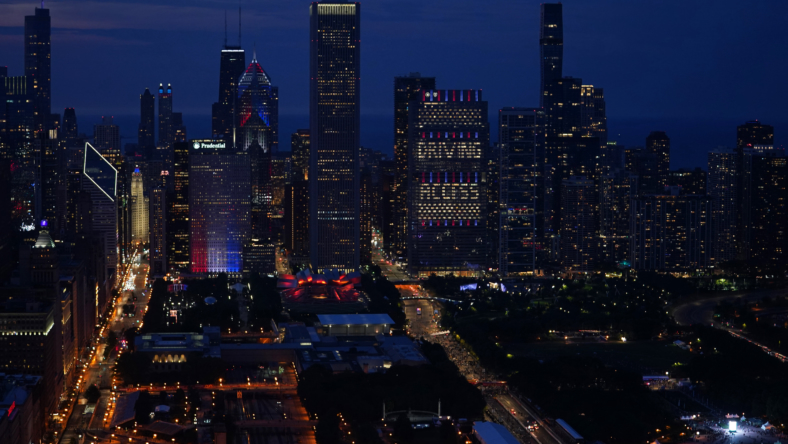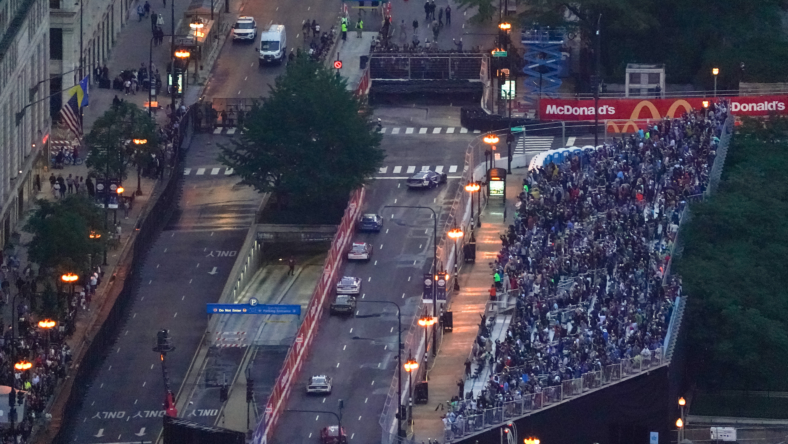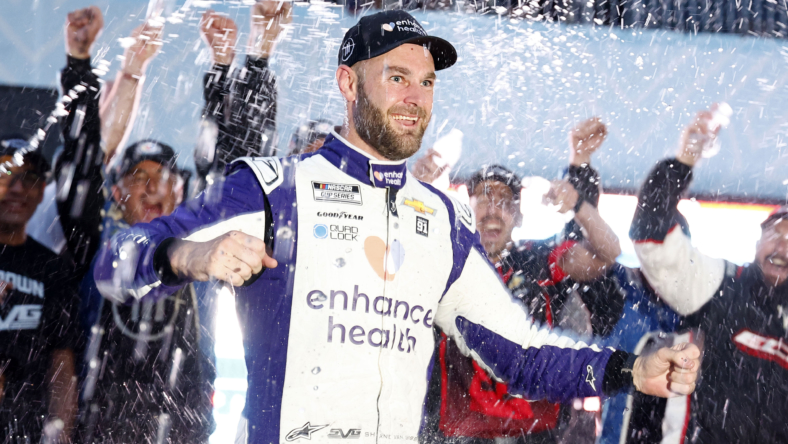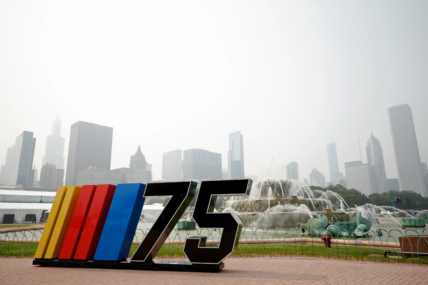
The results of the Chicago Street Race has the potential to change NASCAR in several unique ways, but it will take time to ascertain just how much.
Sure, it wasn’t a wholly successful weekend due to factors outside of NASCAR’s control, primarily regarding the weather and a lightning policy cross-up with the city parks authority but the foundation of the concept came across really sound.
Attendance for the event was really strong with roughly 80 percent of attendees having not appeared in the NASCAR ticket buying database until this weekend. NASCAR, after all, can only grow the sport if they get it in front of new eyes.
The racing was objectively compelling on Sunday and the city genuinely welcomed the industry with open arms. Those were all successes, no matter how unlucky they were with the weather canceling over half of the Xfinity race and several high-profile concerts, which included the Chainsmokers and Miranda Lambert.
In the short term, NASCAR will have to renegotiate the terms of a three-year agreement it made with previous Chicago mayor Lori Lightfoot. Prior to this weekend, there was a strong perception that this event would be a one-and-done but there was so much positivity generated throughout the city that even current mayor Brandon Johnson seemed impressed by the spectacle brought to Grant Park.
There is so much that could change over the next several months, especially with NASCAR wanting to finalize a 2024 schedule prior to October, but everyone involved with the inaugural Grant Park 220 seems to want to give the event a fair shake next season with the potential of better weather.
NASCAR’s potential to go global

In the long term, NASCAR chief operating officer Steve O’Donnell didn’t hide the ball on Sunday night over what a successful foundational showing meant for the future.
“We can take the Cup Series anywhere we want,” O’Donnell said. “The race we put on today would sell and be embraced globally.”
Globally, as in international showcases.
It’s no secret that NASCAR aims to continue its expansion into other countries. It already operates international series in Canada, Europe, Mexico and Brazil but the ultimate goal is taking a Cup Series event across the pond.
NASCAR lost a ton of money on the Chicago event this past weekend, and even the most successful version of the event was going to lose a lot of money and the distinction there is intentional. It was an investment.
But you have to look at exact semantics of what O’Donnell said there to understand what that investment went towards.
NASCAR now has the walls, equipment, scoring devices and operational know-how that the next time will be less expensive. It’s surely fair to say that both NASCAR and the City of Chicago would be willing to do another race or two under the same general framework, but this is not the plan longer-term.
This event wasn’t about Chicagoland Speedway versus the streets of Grant Park as so many fans wanted to parse it.
The sanctioning body wanted, and will continue to want, to show the world what an event like this looks like with better weather and better logistical fortune because the tourism revenue is a commercial to any city abroad that wants to bring an American sporting event to their shores.
Will marquee cities start bidding for NASCAR races?
From both a domestic and international standpoint, NASCAR has created an event that very well could eventually generate revenue instead of spending it. Rather than NASCAR spending its own capital to host a race in a marquee city, it could instead open up a date on the Cup Series schedule to the highest bidding city.
Listen, NASCAR spent upwards of $50 million to build and promote this event and that amount drew a little bit of ire from team owners who are currently negotiating with the league over how to split the next television rights agreement.
If the sanctioning body has told them there is no more money to give them, and then proceeds to spend $50 million to produce a street race, it has to be with the caveat that their goal is to open up a potential revenue stream that will also trickle down to the teams.
Even in the short term, several teams were able to sign sponsorships for the Chicago Street Course that only racing in a downtown setting would allow them to acquire.
“If you look at my car and you look at the sponsor this weekend: We have Elk Grove, which is a local community here with a big manufacturing initiative, and those are opportunities that are afforded to us by being in such a unique market as we are here in Chicago,” Brad Keselowski said. “I don’t think these are partnerships that we’d be able to land elsewhere.”
So now think about the sponsorship teams could land by racing abroad.
But to get there, international cities and NASCAR by way of an event title sponsor, would need to pay for it because there is no way teams are going to sign off on international races as an investment it must incur when it is still reeling from the investment of the Next Gen car last year.
But that Chicago was successful, despite the bad luck, portends good things for NASCAR’s goals in this regard for the future.
Don’t forget that NASCAR spent $1 million to build the temporary short track within the confines of the Los Angeles Memorial Coliseum the past two years. That very well could be an economic option for hosting races at the likes of Wembley Stadium, Maracanã Stadium, Camp Nou or Estadio Azteca.
All told, the past two years of stadium and street racing has created multiple pathways for NASCAR to get cities across the world to pay the league to bring a show to their backyards that doesn’t include building a permanent facility that could soon sit dormant like Chicagoland Speedway or Kentucky Speedway.
Oval racing will always be the steak and potatoes of NASCAR racing but the sanctioning body is wisely exploring ways to expand and create business opportunities for itself, teams and drivers alike.
What Shane van Gisbergen’s win means for Supercar stars

In the same way that a successful race weekend could change the complexion of future Cup Series schedules, Shane van Gisbergen winning on the Streets of Chicago could change the complexion of the full-time grid.
Van Gisbergen is contractually obligated to continue racing for Triple Eight Racing in the Australian Supercars series but has shown a willingness to race full-time in Cup by 2025. But team owner Jamie Whincup told FOX Sports Australia that he would not hold the three-time champion to that contract if such a call came from a NASCAR team owner.
“He’s only contractually bound to us for next year,” Whincup said. “Of course I’m trying to run the business as well as a I possibly can and I need the best drivers, but if any driver, engineer, employee came to me and said, ‘Hey, my dream is to go to the other side of the world and do something else’, I’m not going to stand in their way.
“I want to open up opportunities for all my staff. No doubt we’re going to have some discussions in the next month or so and work out what he wants to do. He’s certainly got my praise whatever he wants to do, and we’re going to support him all the way.”
It wasn’t that Van Gisbergen came over and immediately won a race in his debut. It was about how far and away better than everyone else he was over the weekend.
Sure, he was driving a Cup Series car inspired heavily by the Australian Supercar on a type of track Cup Series drivers have never raced on before, but it stands to reason that drivers like van Gisbergen should be in-demand for next season.
Several teams are expected to have openings and the case could be made that a van Gisbergen or Brodie Kostecki would be immediately competitive on road and street courses. Sure, the learning curve could be steep on ovals but Kostecki in particular has several years of experience racing on ovals in the United States before returning home to compete in Supercars.
Kostecki had already started exploring a move to NASCAR before van Gisbergen won and the results of Sunday has created a market opportunity for drivers with their experience with these cars, on those types of tracks. That Kostecki, the current Supercars championship leader, already has an oval background makes him all the more valuable this summer.
Chicago very well could have changed both the tracks that NASCAR races at in the future and who specifically will race on them.
Matt Weaver is a Motorsports Insider for Sportsnaut. Follow him on Twitter.
